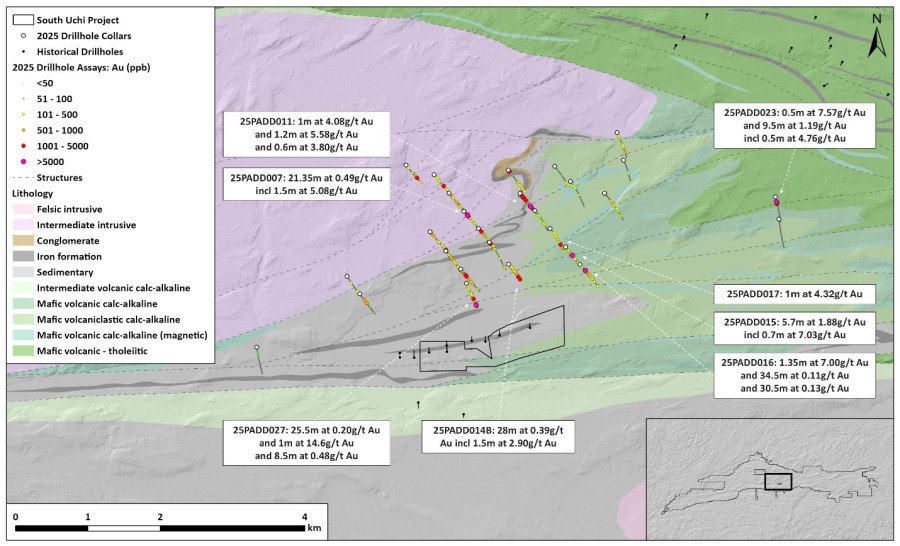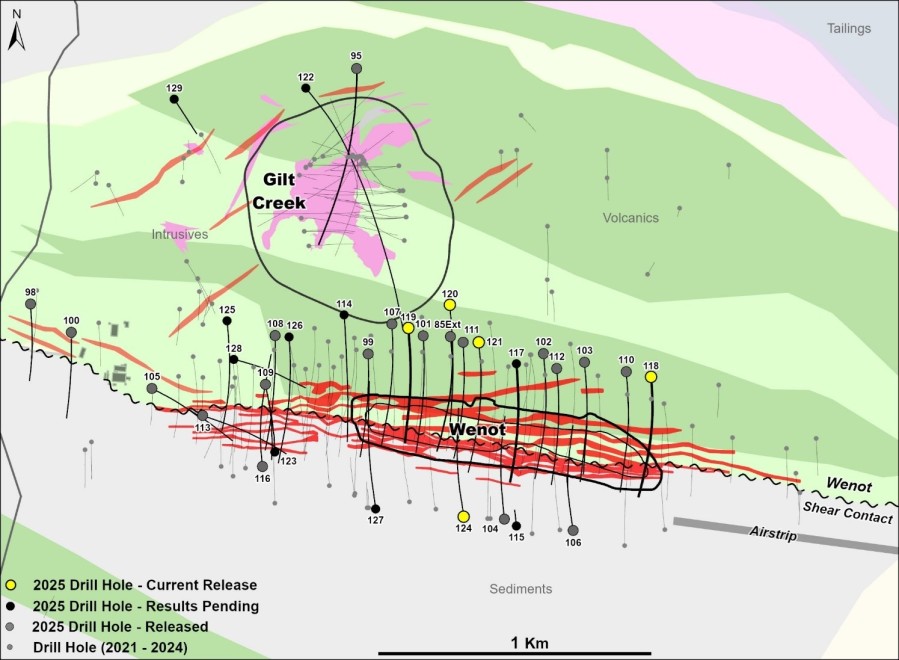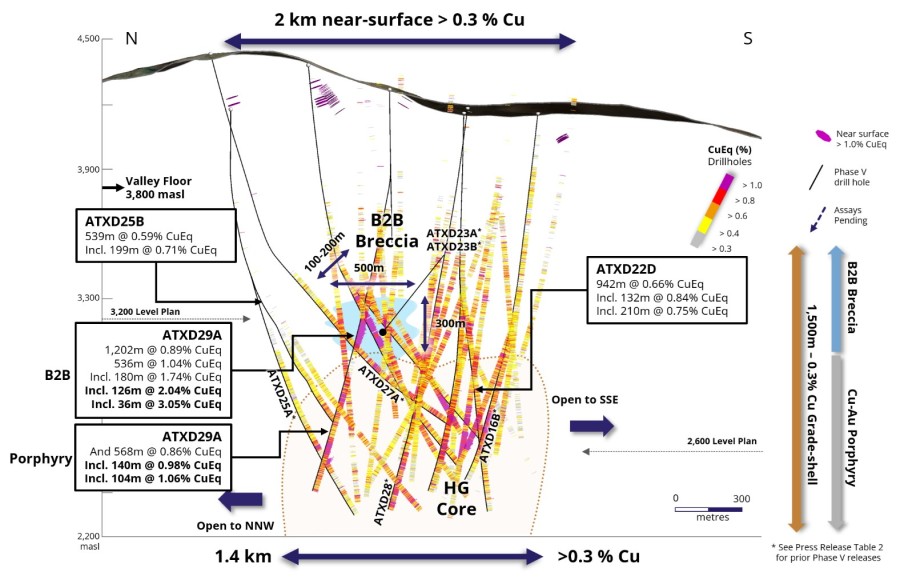Vancouver, British Columbia--(Newsfile Corp. - August 9, 2017) - Alset Minerals Corp. (TSXV: ION) ("Alset" or "the Company") is pleased to report that the phase one drilling program at La Salada salar in Zacatecas, Mexico has been completed. This is the first of 13 salars that will be tested. Alset has a 100% interest in 13 salars covering an area of approximately 4,500 hectares, all within 100 kilometres of the city of Zacatecas.
Highlights of Drilling
- Grid completed over La Salada salar with 1 deep hole (see Company news release dated 15 May 2017) and 40 auger holes over the majority of known surface salar extent;
- 38 brine and 428 soil samples recovered;
- High of 27,300 mg/L potassium (K) in near surface brine with an average of 12,718 mg/L;
- High of 40,000 mg/L sulphate (SO4) in near surface brine with an average of 16,594 mg/L;
- High of 1,860 ppm lithium (Li) in soil with an average of 724 ppm;
- High of 6.45% of potassium (K) in soil with an average of 3.73%;
- Low exploration costs due to infrastructure (roads and power) around the La Salada salar.
Allan Barry Laboucan, President and CEO of Alset said: "This program at La Salada was the first chance for Alset to carry out a significant drill program to get a better understanding of the chemical compositions in the near surface brines as well as soils down to an average of 14 metres. An important attribute of our salars that became very clear was the cost of exploration compared to similar work in remote locations. We are experiencing the benefits of good roads and power that will continue to enhance the project as we move forward to do more testing to better understand the potential of La Salada and our other salars. In the event of a mine being built the infrastructure will continue to enhance the economic potential.
Based on these results, we are now ready to move forward with metallurgical work to understand the leaching characteristics of the soils and to further explore for brine and aquifer potential at depth. In addition to the work completed at La Salada, we completed a first pass auger sampling program over Santa Clara, Saldivar, Caliguey, Colorada, Chapalla salars and some of our recently acquired salars. Those samples results are currently pending; we hope to report them in the next few weeks.
The brine results showing high potassium, high sulphate, low calcium and low magnesium suggest the possibility of producing potassium salts at La Salada using solar evaporation. We have an outstanding salar at La Salada that is showing a lot of potential for significant resources of lithium, potassium and other minerals needed for farming."
Tables showing the soil and brine results mentioned in this news release are given below. The complete data set for this work and our past lab work can be found on Alset's corporate website in the lab results section.
Table 1: Summary of Soils Data by Drill Hole
|
Max |
Weighted Averages |
||||||||
|
Depth |
K |
Li |
B |
K |
Li |
B |
|||
|
Hole ID |
Location |
(m) |
(%) |
(ppm) |
(ppm) |
(%) |
(ppm) |
(ppm) |
|
|
LS17-AG005 |
south |
15.6 |
3.76 |
1,840 |
790 |
3.01 |
1,633 |
630 |
|
|
LS17-AG013 |
south |
21.0 |
6.32 |
1,860 |
638 |
3.75 |
895 |
428 |
|
|
LS17-AG019 |
centre |
24.0 |
5.68 |
1,530 |
849 |
3.42 |
932 |
568 |
|
|
LS17-AG028 |
north |
11.5 |
5.21 |
1,270 |
823 |
3.87 |
629 |
440 |
|
|
LS17-AG034 |
north |
8.0 |
6.11 |
1,020 |
984 |
4.29 |
528 |
666 |
|
|
ALL AUGER HOLES |
14.4 (avg) |
3.58 |
975 |
535 |
|||||
|
LS17-TT01 |
north |
51.4 |
6.45 |
790 |
574 |
4.05 |
196 |
249 |
|
|
ALL SAMPLES |
6.45 |
1,860 |
984 |
3.73 |
724 |
443 |
|||
Table 2: Summary of Brine Results
|
Hole ID |
Sample ID |
Potassium (mg/L) |
Sulphate (mg/L) |
Boron (mg/L) |
Lithium (mg/L) |
Calcium (mg/L) |
Magnesium (mg/L) |
|
LS17-AG002 |
547 |
3,540 |
2,800 |
46.5 |
3 |
65.7 |
62.9 |
|
LS17-AG003 |
544 |
575 |
1,300 |
23.2 |
2 |
49.4 |
45.9 |
|
LS17-AG004 |
549 |
7,000 |
10,000 |
134 |
4 |
15.6 |
12.6 |
|
LS17-AG005 |
504 |
7,750 |
9,200 |
156 |
4 |
21.7 |
22.1 |
|
LS17-AG006 |
505 |
3,970 |
4,600 |
83.0 |
2 |
19.8 |
19.4 |
|
LS17-AG008 |
543 |
683 |
490 |
19.4 |
7 |
395.0 |
266.0 |
|
LS17-AG009 |
523 |
2,940 |
3,100 |
55.7 |
2 |
16.8 |
8.2 |
|
LS17-AG010 |
517 |
3,530 |
3,200 |
61.5 |
3 |
79.0 |
18.2 |
|
LS17-AG011 |
516 |
4,970 |
3,000 |
64.4 |
3 |
3.9 |
3.6 |
|
LS17-AG012 |
508 |
4,900 |
3,800 |
82.3 |
3 |
3.6 |
4.2 |
|
LS17-AG014 |
522 |
12,500 |
18,000 |
249 |
4 |
3.1 |
2.0 |
|
LS17-AG016 |
518 |
17,800 |
18,000 |
284 |
8 |
7.6 |
10.0 |
|
LS17-AG017 |
519 |
22,000 |
23,000 |
377 |
11 |
12.8 |
10.0 |
|
LS17-AG018 |
521 |
23,800 |
31,000 |
465 |
13 |
68.7 |
97.0 |
|
LS17-AG020 |
520 |
18,700 |
16,000 |
285 |
12 |
60.1 |
89.2 |
|
LS17-AG021 |
542 |
2,080 |
3,800 |
78.3 |
< 1 |
39.2 |
42.8 |
|
LS17-AG022 |
525 |
8,830 |
8,100 |
135 |
6 |
4.4 |
1.6 |
|
LS17-AG024 |
541 |
711 |
610 |
12.2 |
1 |
20.9 |
30.9 |
|
LS17-AG025 |
550 |
16,900 |
30,000 |
431 |
14 |
441.0 |
213.0 |
|
LS17-AG026 |
528 |
23,100 |
36,000 |
497 |
13 |
7.7 |
3.6 |
|
LS17-AG027 |
527 |
14,200 |
17,000 |
296 |
11 |
9.7 |
2.2 |
|
LS17-AG028 |
513 |
8,860 |
9,800 |
145 |
6 |
22.3 |
9.8 |
|
LS17-AG029 |
530 |
22,500 |
36,000 |
544 |
16 |
4.7 |
5.2 |
|
LS17-AG030 |
531 |
24,000 |
31,000 |
431 |
13 |
20.9 |
16.0 |
|
LS17-AG031 |
532 |
22,800 |
34,000 |
515 |
20 |
30.8 |
17.6 |
|
LS17-AG032 |
540 |
4,820 |
4,300 |
28.9 |
2 |
10.4 |
5.3 |
|
LS17-AG034 |
511 |
27,300 |
40,000 |
677 |
22 |
3.4 |
1.1 |
|
LS17-AG035 |
534 |
21,500 |
27,000 |
410 |
15 |
18.8 |
9.3 |
|
LS17-AG036 |
539 |
7,010 |
7,900 |
96.8 |
3 |
49.6 |
21.6 |
|
LS17-AG037 |
535 |
21,700 |
34,000 |
524 |
16 |
217.0 |
44.2 |
|
LS17-AG038 |
537 |
22,800 |
33,000 |
565 |
21 |
19.7 |
8.0 |
|
LS17-AG039 |
536 |
23,200 |
31,000 |
481 |
16 |
85.8 |
52.2 |
|
Max |
27,300 |
40,000 |
677 |
22 |
441.0 |
266.0 |
|
|
Average |
12,718 |
16,594 |
258 |
9 |
57.2 |
36.1 |
Discussion of Drill Program
At La Salada 1 deep hole (51.35 m) and 40 auger holes were completed, both near surface brine samples and extensive soil samples were recovered. Auger holes ranged from 4.5 to 26.0 metres and averaged 14.4 metres in depth, they were completed on a 150-200 metre grid covering the entire salar for a total area of some 1,800 metres by 900 metres.
Composite soil samples were taken along 1.0 to 3.0m intervals in the deep hole, and along 1.5 metre intervals in the auger holes. To date assays for samples from 5 of these auger holes and the deep hole, 74 samples in total, have been completed with 33 holes pending. Assays returned significant lithium and potassium values. Lithium results ranged from 79 to 1,860 ppm, with a weighted average of 724 ppm, potassium ranged from 1.52% to 6.45% with a weighted average of 3.73% (Table 1).
Near surface brine samples were collected from 38 of the auger holes. These results returned high potassium and high sulphate values. For the brine samples, potassium peaked at 27,300 mg/L with an average of 12,718 mg/L, sulphate peaked at 40,000 mg/L with an average of 16,594 mg/L. These results are shown in Table 2. These results indicate that further work, to identify potential brines and aquifers at depth, depth to bedrock, brine volumes and recharge rates, is warranted.
From this drilling program, it is becoming clear the La Salada salar is emerging as a unique project with relatively high values of lithium and potassium in the soils and high values of potassium and sulphate in the near surface brines. Soil sampling of the southern portion of La Salada returned the highest lithium values. The northern portion of the salar contained the highest concentration of potassium in both the soils and brines as well as sulphate in the brines. Brine sampling at the very northern edge of the salar returned some of the highest potassium, sulphate and boron results, suggesting that the salar and subsurface brines may continue to the north beyond the scope of the recent drill program.
Analytical Work
The drilling program and associated analytical work was designed to better understand the geochemistry and deportment of lithium and other minerals in subsurface soils and brines in the La Salada salar. However, it must be stated that to date the primary focus of our drilling has been to assess the near surface infill soil layer, approximately 15 metres, including the near surface brines in that layer. The mineralization potential beyond the near surface material is still open.
Based on these results, it is clear Alset's La Salada salar has significant soil and near surface brine potential. Alset will continue to investigate the lithium and potassium potential of the soils, and the potential for potassium and sulphate in the near surface brines as well as brines at depth.
Moving forward, staged leach testing using hot water and single acid leaches will be conducted on composite samples generated from the 74 samples reported. Following leach testing, mineralogy and grain size distribution of these soils will be evaluated and further metallurgical testing will be conducted on the remaining soil samples collected during the auger program.
Quality Assurance and Quality Control
Samples were submitted to SGS Durango for processing and then shipped to SGS Lakefield for analysis. Soils were analyzed for geochemistry using an inductively coupled plasma optical emission spectrometry (ICP-OES) procedure with a four-acid digestion. Brines were analyzed for geochemistry using an ICP-OES procedure, water soluble Cl and SO4 were analyzed by ion chromatography.
Soil samples were submitted to SGS with 1 duplicate set, the laboratory used its own quality control and quality assurance protocols for sample analysis. For additional QA/QC purposes, duplicate samples from 1 auger hole (14 samples) were submitted to ALS Zacatecas and ALS North Vancouver along with 1 duplicate sample, 1 blank and 2 standards with different lithium ranges (796ppm and 1,712ppm). The blanks and standards were obtained from MEG Inc, Nevada. Duplicate, blank and standard results using 4-acid digestion followed by inductively coupled plasma atomic emission spectrometry (ICP-AES) were within acceptable ranges and returned similar values to the samples analyzed at SGS Lakefield.
Brine samples were submitted to SGS with 3 sample blanks and 3 sample duplicates and the laboratory used its own quality control and quality assurance protocols for sample analysis. Six samples, including 1 duplicate set, returned values outside of acceptable ranges. The results of these samples are not reported here and these samples are currently being re-evaluated by SGS Lakefield. The results of the blanks and other duplicate samples were within acceptable ranges. Five repeat brine samples were collected 1 month after the completion of drilling and submitted to ALS North Vancouver and Burnaby along with 1 duplicate sample, 1 blank and 2 standards. The standards were manufactured at Inorganic Ventures, Virginia and include one low salinity standard with 60 mg/L Li; and one medium salinity standard with 190 mg/L Li. Again, all duplicate, blank and standard results were within acceptable ranges.
Emily Hanson, PGeo, Vice-President of exploration for Alset Minerals, is the qualified person responsible for this release and has prepared, supervised and approved the preparation of the scientific and technical disclosure contained within the release.
About Alset Minerals
Alset Minerals Corp. is a TSX-V listed junior exploration company focused on exploring and development of a group of high-grade lithium and potassium projects in the Central Mexican Plateau. The Company is actively exploring in Mexico.





